We’ve really been on the move since we left China proper. One day in Hong Kong, one day in Macau, one day in Hong Kong, one day in Seoul, and one long bus ride to spend an evening in Busan.
I’m always reluctant to leave Hong Kong, which has one of the finest skylines in the world. I’ve been there often enough to think of it as “my” city–as in my optician, my tailor, and my friend Eleanor, whom I met in 1995 in Saigon at a conference and who over the years has been a great help to me and to IWU students whenever either is in Hong Kong. I have what the Chinese call “guanxi,” which comes from repeated business and a Chinese-like sense of humor. My Chinese name for me is “Weidade Jiaoshou,” which for those who do not speak Chinese means “Great Teacher.” It proves that if you write your own copy, you can write anything you desire, whether true or not. And they do remember me by name.
I’m not sure I mentioned two features of Macau which make it distinctive in Asia. The first is that it was neutral in World War II (as a Portuguese possession); second, it was not part of the Cultural Revolution. The combination means that the Luso-Chinese (look that up in your dictionary) architecture has remained, unless torn down to make way for the high rises that dot every city in Asia. The pastels and stucco are quite stunning, but it was raining and we did not get to go to one of my favorite sights–the Protestant Cemetery, which has graves demonstrating the dangers of the far east–death at sea, in battle, in childbirth.
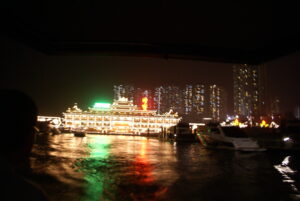 I spent the last night in Hong Kong walking the waterfront facing the island of Hong Kong with my friend until it was time to take the ferry (did I tell you that as a concessionaire–British for Old Guy–I get to ride the ferry for free and get half price on other transportation–and have a separate channel through customs!). Next time more time! Incidentally, Britain acquired Hong Kong in stages; the island ceded in perpetuity in 1842, the Kowloon peninsula surrendered in 1860s, and the New Territories, loaned for 99 years in 1898. The end of the lease for the New Territories was what triggered the return of Hong Kong.
I spent the last night in Hong Kong walking the waterfront facing the island of Hong Kong with my friend until it was time to take the ferry (did I tell you that as a concessionaire–British for Old Guy–I get to ride the ferry for free and get half price on other transportation–and have a separate channel through customs!). Next time more time! Incidentally, Britain acquired Hong Kong in stages; the island ceded in perpetuity in 1842, the Kowloon peninsula surrendered in 1860s, and the New Territories, loaned for 99 years in 1898. The end of the lease for the New Territories was what triggered the return of Hong Kong.
When we got to Seoul, I realized I was not in China any longer. I am in the Chinese sphere of influence, both past and present though! It helps to understand the nationalism of Koreans when you realize that, as a guide told me on my first trip here, either the Chinese or the Japanese invade every hundred years. It’s China’s turn because the Japanese colonized Korea from 1910 through 1945–forcing the Koreans to adopt Japanese names, forbidding the religion, and generally behaving like a superior race. There’re a lot of reminders of the occupation. For example, we had to take one of the boys to a hospital–he was dehydrated. While we were waiting for the IV, Dr. Park and I walked across the street to a park that was new since he left Seoul to work and study in the U.S.–the centerpiece to the park is the prison where Japanese incarcerated independence advocates over the years.
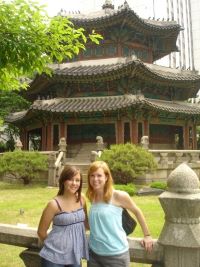
The Chinese influence is equally marked in the culture and the history. We toured one of the palaces in Seoul yesterday, and having been in Xi’an a few days ago, we saw Tang China. I still marvel at the power of Chinese civilization to reach Korean and Japan–before the information superhighway was even a trail. To be an emperor in Asia meant adopting Buddhism, Confucianism, and the imperial way. Both Japan and Korea even used Chinese characters (despite the fact that King Sejong in the 15th century developed a Korean alphabet that only today has begun to replace the Tang period characters that I saw alongside the Korean when I first came here).
There’s also a lot of western influence in Korea, partly because 58 years ago, North Korea invaded South Korea. Within three days, Seoul was captured (for the first of what I think was three times, which explains why the city is mostly new or renovated), and within three months had pushed the American and UN forces (mostly American) to the Pusan perimeter, which is where we’re staying tonight. General MacArthur then planned an amphibious landing at Inchon that punctured the overextended North Korean lines and rolled up the peninsula until he scared the Chinese, who lent their support and military to North Korea, threatening World War.
The Chinese pushback made the Korean War one of the decisive factors in 20th century Asia. As a result, the United States did not recognize the People’s Republic of China until Richard Nixon’s presidency; it intervened in the Civil War by using the U.S. Fleet to protect the other China, and it extended American influence in VietNam to the point that after 1954, we replaced the French. Important war (if you’re interested, David Halberstam’s book on the Coldest Winter is fascinating). As we drove down here, on a very modern highway full of traffic, we could see that the country really is 70 percent mountainous, highly urbanized, and very difficult battle terrain.
One other Western influence that we took advantage of–and one of the important points in the development of South Korea–was the 1988 Olympics. About that time, the military coalitions that had dominated Korea from its independence were overthrown by the democratic governments that we see today. The current political climate with the U.S. is marred by protests against a treaty the Korean president has been pushing to allow U.S. beef to be admitted to Korea. The protesters were at the presidential palace when we stopped by, and Professor Park engaged them in
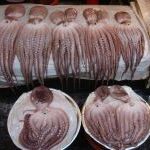
discussion–he was in the same class with one of the senators. Unlike protests in the past when I’ve been here, the police sat in a bus. Previously, they would stand outside with their battle shields and helmets and tear gas…
here, the police sat in a bus. Previously, they would stand outside with their battle shields and helmets and tear gas…
The shorter story was that as a result of the American assistance (we had 7th Army HQ in downtown Seoul until a few years ago) and the Olympics, baseball is popular here. We went to Olympic Stadium to see the LG Twins play the Kia Tigers (the corporations sponsor the 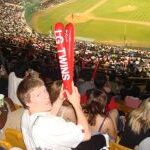
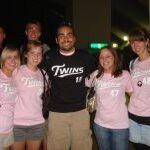 teams–great marketing). It was 3 hours of disco baseball, a combination of basketball and soccer, with never a quiet moment. The baseball was pretty good, but the food was Burger King (a bulgogi Whopper was available–the Koreans love beef, and Bulgogi is a heavily marinated meat) and KFC.
teams–great marketing). It was 3 hours of disco baseball, a combination of basketball and soccer, with never a quiet moment. The baseball was pretty good, but the food was Burger King (a bulgogi Whopper was available–the Koreans love beef, and Bulgogi is a heavily marinated meat) and KFC.
And the Korean village reconstructed at Suwon with traditional crafts and residences!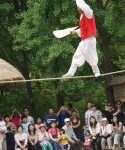
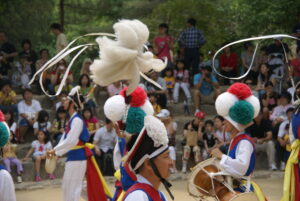
As I said, I’m not in China, and I’m enjoying Seoul Food!
Eat Kimchee and smile!